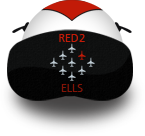Be sure not to mix your terms Afneer- an aileron roll is a pure aileron roll, a snap roll is accomplished with pitch and yaw. But yes to make nice level continuous rolls all the control surfaces must be coordinated.afneer wrote:Anyone else notice the solo's aileron rolls? There was definitely some rudder/elevator input. I never realized they did that but always thought it was just aileron snap rolls. A bit more risk factor I would think.
Now in an F-16 this is largely accomplished by the Flight Control Computer- to get in depth the F-16s FLCC is a Pitch Rate Command system. This means that moving the stick tells the jet to move its nose around in the air and if you release the stick the FLCC will keep the nose where you point it until told otherwise. This is unique from most aircraft with FLCC's, the F/A-18 and F-15 have the more standard a pitch trim system, meaning they are constantly seeking 1.0g when the stick is in the neutral position, meaning if you pitch the nose up and roll over the aircraft will seek 1.0g and the nose will fall of its own accord. In LOMAC we fly the F-15 which has the pitch trim system, this means that when we do continuous aileron rolls we must constantly fight the aircrafts tendency to nose down when inverted. This leads to the technique of pushing and pulling while rolling to keep the nose nicely pointed just above the horizon. But in a real F-16 pitch coordination is handled by the FLCC and I'm pretty sure the pilot does not have to jump all over the pitch and rudder inputs, the magic box does it all for him.
Sorry about the information overkill


